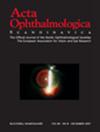Myopia control with orthokeratology lenses. A 3-year follow-up study including a cross-over design: Clinical study Of Near-sightedness; TReatment with Orthokeratology Lenses 2 (CONTROL2 study)
Abstract
Purpose
The purpose of this study is to investigate 3-year efficacy of orthokeratology lenses (OKL) in controlling axial length progression in myopic Scandinavian children. Through a cross-over design of the control group to compare the treatment efficacy in younger versus older children, with the latter having higher cycloplegic spherical refractive error (cSEQ) at treatment initiation. Further, the study aimed to evaluate the safety of the treatment.
Methods
This was a continuation of the randomized controlled study Clinical study Of Near-sightedness; TReatment with Orthokeratology Lenses (CONTROL study) in which the follow-up period of the original intervention group, that received OKL, was extended from 18 months to 36 months. Meanwhile, the original control group was crossed-over to OKL after the 18-month follow-up visit and treated for 18 months. Biometry was measured using Lenstar LS900, and contact lens complications were graded according to Efron Grading Scale for Contact Lens Complications (Efron score). Mixed models were used for statistical analysis.
Results
Nineteen subjects in the OKL group and 28 in the control group completed the CONTROL study. Hereof, 17 and 24 subjects from the OKL group and control group, respectively, agreed to participate in the CONTROL2 study. In the OKL continue group, the treatment efficacy did not decline during the 3-year study period (p-values for follow-up visits were all ≥0.82). There was no statistically significant difference between treatment efficacy when OKL treatment was initiated in younger versus older children (p-value ≥0.14 for all follow-up visits). Low-grade corneal staining was seen in several subjects at some point during the study, but here were no treatment-requiring or sight-threatening adverse events during the study period.
Conclusion
The efficacy of myopia control by OKL was stable during 3 years of treatment. Similar treatment efficacies were found regardless of the age at treatment initiation. No severe adverse events occurred during the study period.


 求助内容:
求助内容: 应助结果提醒方式:
应助结果提醒方式:


